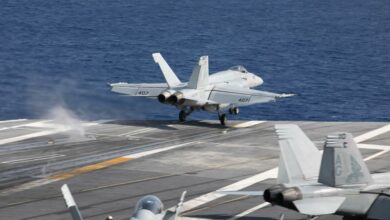US Navy Shock Tests Unmanned Underwater Minesweeper
The US Navy completed underwater explosion shock testing of its new unmanned minesweeper, gauging the system’s endurance and capabilities in hazardous environments.
The Aberdeen Test Center and Naval Surface Warfare Center tested the Textron-developed Unmanned Influence Sweep System (UISS), which can be “hosted from littoral combat ships, operated from shore or vessels of opportunity.”
The evaluation is part of a series of tests to ensure the system’s scheduled initial operating capability this year. The navy has ordered four to replace its aging Avenger-class minesweeping ships and MH-53E Sea Dragon helicopters.
Unmanned Influence Sweep System
The UISS is based on Textron’s Common Unmanned Surface Vehicle, an aluminum-hulled mine countermeasures unmanned surface vehicle (MCM USV), and a towed minesweeping payload to counter acoustic and magnetic mines.
Naval Sea Systems Command official Colleen E. O’Rourke explained in 2017 that the UISS payload includes a magnetic cable towing a modified Mk-104 acoustic device, which “generates an acoustic source by cavitation and the specialized cable creates an electromagnetic field. The output of these two emitters generates the appropriate fields that satisfy the mine logic so that the mine detonates.”

Modular Payload
The MCM USV, deployable with modular payloads for additional MCM capabilities, is undergoing integration testing of the AQS-20C towed minehunting sonar for “detection, identification, classification, and localization of volume and bottom mine-like objects.”
LCS Mission Modules Program Manager Capt. Godfrey “Gus” Weekes remarked that the “completion of these tests showcased the capability and resiliency of the MCM USV, and is a critical milestone for the program.”
“The MCM USV is the centerpiece of the MCM mission package, and this test demonstrates the final steps we’re taking for MCM mission package IOT&E and fielding.”












